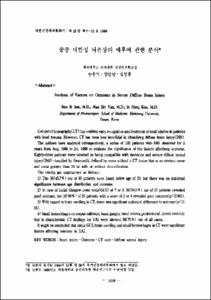KUMEL Repository
1. Journal Papers (연구논문)
1. School of Medicine (의과대학)
Dept. of Neurosurgery (신경외과학)
중증 미만성 뇌손상의 예후에 관한 분석
- Keimyung Author(s)
- Son, Eun Ik; Yim, Man Bin; Kim, In Hong
- Department
- Dept. of Neurosurgery (신경외과학)
- Journal Title
- 대한신경외과학회지
- Issued Date
- 1989
- Volume
- 18
- Issue
- 7~12
- Abstract
- Computed tomography(CT) has enabled early recognition and treatment of focal injuries in patients with head trauma. However, CT has been less beneficial in identifying diffuse brain injury(DBI).
The authors have analyzed retrospectively, a series of 132 patients with DBI observed for 2 years from Aug. 1986 to Jul. 1988 to evaluate the significance of the factors affectiong ourcome. Eighty-three patients were selected as being compatible with moderate and severe diffuse axonal injury(DAI) classified by Gennarelli, defined by coma without a CT lesion that is an obvious cause and coma greater than 24 hr with or without decerebration.
The results are summarized as follows:
1) The 38(45.7%) out of 83 patients were found below age of 20, but there was no statistical significance between age distribution and outcome.
2) In case of initial Glasgow coma scale(GCS) of 7 or 8, 32(86.5%) out of 37 patients revealed good outcome, but 18(90%) of 20 patients with a score of 3 or 4 revealed poor outcome(p<0.001).
3) With regard to brain swelling in CT, there was significant statistical difference to outcome(p<0.05).
4) Small hemorrhages on corpus callosum, basal ganglia, basal cistern, peritentorial, lateral ventricle that is characteristic CT findings for DAI were showed 58(70%) out of cases.
It might be concluded that initial GCS, brain swelling and small hemorrhages in CT were significant factors affecting outcome in DAI.
- Alternative Title
- Analysis of Factors on Outcome in Severe Diffuse Brain Injury
- Publisher
- School of Medicine
- Citation
- 손은익 et al. (1989). 중증 미만성 뇌손상의 예후에 관한 분석. 대한신경외과학회지, 18(7~12), 1038–1044.
- Type
- Article
- ISSN
- 1225-8245
- Appears in Collections:
- 1. School of Medicine (의과대학) > Dept. of Neurosurgery (신경외과학)
- 파일 목록
-
-
Download
 oak-bbb-1599.pdf
기타 데이터 / 335.4 kB / Adobe PDF
oak-bbb-1599.pdf
기타 데이터 / 335.4 kB / Adobe PDF
-
Items in Repository are protected by copyright, with all rights reserved, unless otherwise indicated.